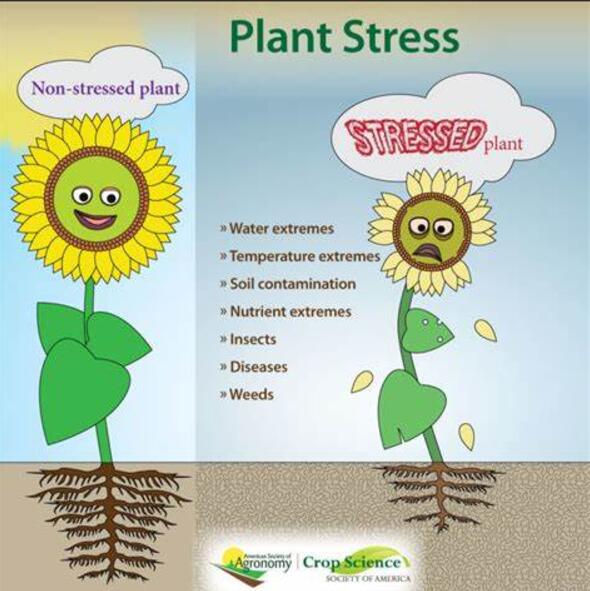Early monitoring of drought stress in safflower (Carthamus tinctorius L.) using hyperspectral imaging: A comparison of machine learning tools and feature selection approaches
IF 6.8
Q1 PLANT SCIENCES
引用次数: 0
Abstract
Early detection of drought stress is essential for preventing permanent plant damage and minimizing yield loss. This study utilized hyperspectral imaging at the leaf level to visualize drought stress in safflower plants (Carthamus tinctorius L.). Three safflower genotypes, Palenus, A82, and IL-111, were cultivated under three irrigation levels. Stress conditions were simulated by depleting 50%, 70%, and 90% of soil water content, representing unstressed (US), mild stress (MS), and severe stress (SS) conditions, respectively. Hyperspectral images of leaf samples were captured before any visible signs of water scarcity emerged. Classification analysis was performed using the full mean spectral data with partial least squares discriminant analysis, soft independent modeling of class analogy (SIMCA), support vector machines, and artificial neural network (ANN) classifiers. Feature selection methods were applied to extract the most informative wavebands, and ANN was used to build predictive models. Spatial analysis involved pixel-wise classification using both unsupervised (k-means clustering) and supervised (best classifiers) approaches. ANN outperformed other classifiers using the entire spectral data, effectively distinguishing US, MS, and SS classes in the Palenus, A82, and IL-111 genotypes, achieving F1-scores of 92.22%, 96.01%, and 96.47%, respectively. Among the feature selection methods, SIMCA-based features excelled in monitoring stress conditions in the Palenus and A82 genotypes. In supervised spatial analysis, ANN models clearly depicted the progression of stress in leaves across different genotypes. This study demonstrates the potential of hyperspectral imaging to differentiate various levels of drought stress in safflower, an important oilseed crop.
利用高光谱成像技术对红花(Carthamus tinctorius L.)的干旱胁迫进行早期监测:机器学习工具和特征选择方法的比较
及早发现干旱胁迫对于防止植物遭受永久性损害和最大限度地减少产量损失至关重要。本研究利用高光谱成像技术在叶片层面观察红花植物(Carthamus tinctorius L.)的干旱胁迫。在三种灌溉水平下栽培了三种红花基因型:Palenus、A82 和 IL-111。通过消耗土壤含水量的 50%、70% 和 90%模拟胁迫条件,分别代表未胁迫(US)、轻度胁迫(MS)和严重胁迫(SS)条件。叶片样本的高光谱图像是在出现任何明显的缺水迹象之前采集的。使用偏最小二乘判别分析、类比软独立建模(SIMCA)、支持向量机和人工神经网络(ANN)分类器对全平均光谱数据进行了分类分析。特征选择方法用于提取信息量最大的波段,人工神经网络用于建立预测模型。空间分析包括使用无监督(k-均值聚类)和有监督(最佳分类器)方法进行像素分类。在使用整个光谱数据时,ANN 的表现优于其他分类器,它能有效区分 Palenus、A82 和 IL-111 基因型中的 US、MS 和 SS 类别,F1 分数分别达到 92.22%、96.01% 和 96.47%。在特征选择方法中,基于 SIMCA 的特征在监测 Palenus 和 A82 基因型的胁迫条件方面表现突出。在有监督的空间分析中,ANN 模型清楚地描绘了不同基因型叶片的胁迫进展。这项研究证明了高光谱成像技术在区分红花(一种重要的油籽作物)不同程度干旱胁迫方面的潜力。
本文章由计算机程序翻译,如有差异,请以英文原文为准。
求助全文
约1分钟内获得全文
求助全文
来源期刊

Plant Stress
PLANT SCIENCES-
CiteScore
5.20
自引率
8.00%
发文量
76
审稿时长
63 days
期刊介绍:
The journal Plant Stress deals with plant (or other photoautotrophs, such as algae, cyanobacteria and lichens) responses to abiotic and biotic stress factors that can result in limited growth and productivity. Such responses can be analyzed and described at a physiological, biochemical and molecular level. Experimental approaches/technologies aiming to improve growth and productivity with a potential for downstream validation under stress conditions will also be considered. Both fundamental and applied research manuscripts are welcome, provided that clear mechanistic hypotheses are made and descriptive approaches are avoided. In addition, high-quality review articles will also be considered, provided they follow a critical approach and stimulate thought for future research avenues.
Plant Stress welcomes high-quality manuscripts related (but not limited) to interactions between plants and:
Lack of water (drought) and excess (flooding),
Salinity stress,
Elevated temperature and/or low temperature (chilling and freezing),
Hypoxia and/or anoxia,
Mineral nutrient excess and/or deficiency,
Heavy metals and/or metalloids,
Plant priming (chemical, biological, physiological, nanomaterial, biostimulant) approaches for improved stress protection,
Viral, phytoplasma, bacterial and fungal plant-pathogen interactions.
The journal welcomes basic and applied research articles, as well as review articles and short communications. All submitted manuscripts will be subject to a thorough peer-reviewing process.
 求助内容:
求助内容: 应助结果提醒方式:
应助结果提醒方式:


